Are you ready to go back in time to see how Foundr pulled off our first product launch?
On February 23, Foundr announced that we were launching the latest version of our Instagram online course. This was, and still is, a huge deal for us because it was the first time we had ever attempted to do such a large-scale product launch.
Our goals were to reach $1 million in sales, gain more than 1,000 new students, and dramatically raise awareness of our brand. We’d had steady success and growth with the company and our product offerings, but these were some huge goals for us.
We’ve learned dozens of invaluable lessons on how to launch a product. And since our mission is to offer the best information on entrepreneurship to our audience, we decided to go ahead and document them all here for the Foundr community.
Because here’s the thing about doing a successful product launch, regardless of whether you’re launching a startup, a physical item, or a SaaS: It needs to be a well-oiled machine. There are dozens of moving cogs that all need to work together in harmony if you want to hit the goals you’ve set for yourself.
How We Launched Our First Online Course Successfully
Getting Help With our own Product Launch
One thing that became very apparent to us when we began our product launch was that it was going to take a lot of work. Firing off a couple of emails, opening the cart, and then playing the waiting game just wasn’t going to cut it.
Before our launch of Instagram Domination 2.0, Foundr had done a couple of smaller-scale launches, but nothing as ambitious as this.
We needed to start somewhere, and that somewhere began with Jeff Walker’s Product Launch Formula. We also brought internet marketing legend Ed Dale and his team on as consultants to help guide us through the whole launch process.
Using the Jeff Walker formula as a template, we got to work putting together all the pieces. From figuring out the right videos to use to the best way to use our email list, it soon became apparent that it was going to take months of preparation.
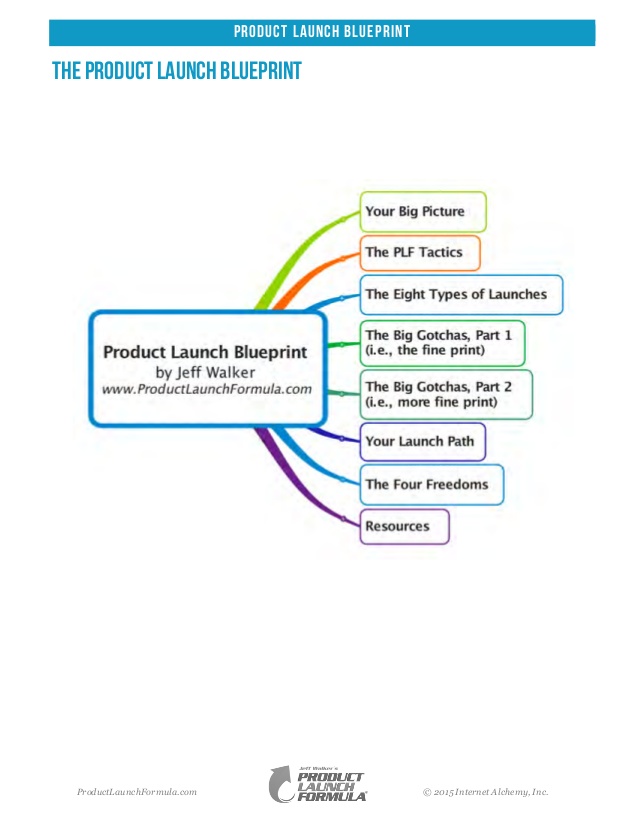
A key feature of the Jeff Walker approach is the concept of constantly providing valuable information and content to your audience at all times, something that matches very well with Foundr’s own ethos. The goal of the product launch isn’t necessarily to make sales but to develop a long-lasting relationship with the customer.
By continuously providing that valuable information to your audience, you’re building a level of trust and loyalty that can’t possibly be gained by just throwing promotion after promotion at your audience.
Another big thing we learned early on is that a product launch should never be treated as a singular event. If anything, it’s the starting point for a whole new journey your business could be taking, depending on how it goes.
A product launch is much more than just announcing to the world that you’re selling something new. In fact, a well-executed product launch could drastically increase the exposure and awareness of your brand. It can lead to more sales, more customers, and a much stronger bottom line for your business in the long run.
The launch itself wasn’t going to be the endpoint of months of hard work. In actuality, all the months of hard work were to prepare us to start the next chapter of Foundr’s story.
Our Process
When Foundr decided to launch its first product, we weren’t a big company by any means.
In fact, not including the affiliates and contractors we worked with, there were only four people in the product launch core team when we first began preparing for the launch.
During a product launch, there are so many steps that need to happen efficiently, in the right order, and with precision. Especially when you’re working with limited resources, it’s crucial to make sure all of those steps are happening, and that you aren’t duplicating any efforts.
Our process has always been clear and simple: record the process for every project, assign it to the right person and right status update, and communicate with the team at every step of the way.
You may be surprised to learn that little has changed in our process. Even though our company has grown ten-fold, we still follow the same tracking system for all of our launches. Not only does this system allow us to keep a project on track, but it also allows clear communication between team members.
Today, we use Asana to organize our projects, but back in the day, we were using Trello as our project management tool.
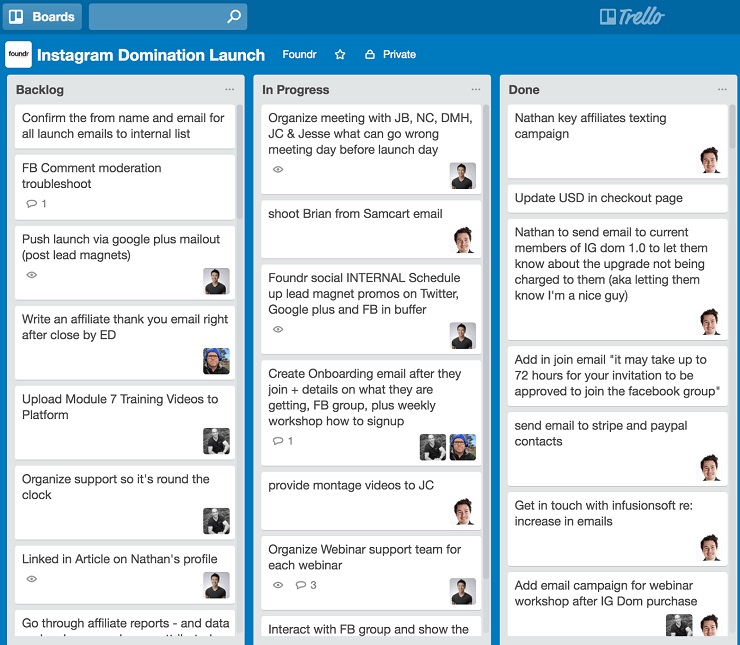
As you can see, we used the standard three columns of backlog, in progress, and done. We would create a card for each specific task that needed to be completed, and then assign them to the appropriate people.
The important part was that the cards had to be as specific as possible. Even something as simple as “provide montage videos to JC” or “Upload Module 7 Training Videos to Platform” had to have their own cards. This ensured that no step was skipped and we could effectively track each task in case something went wrong.
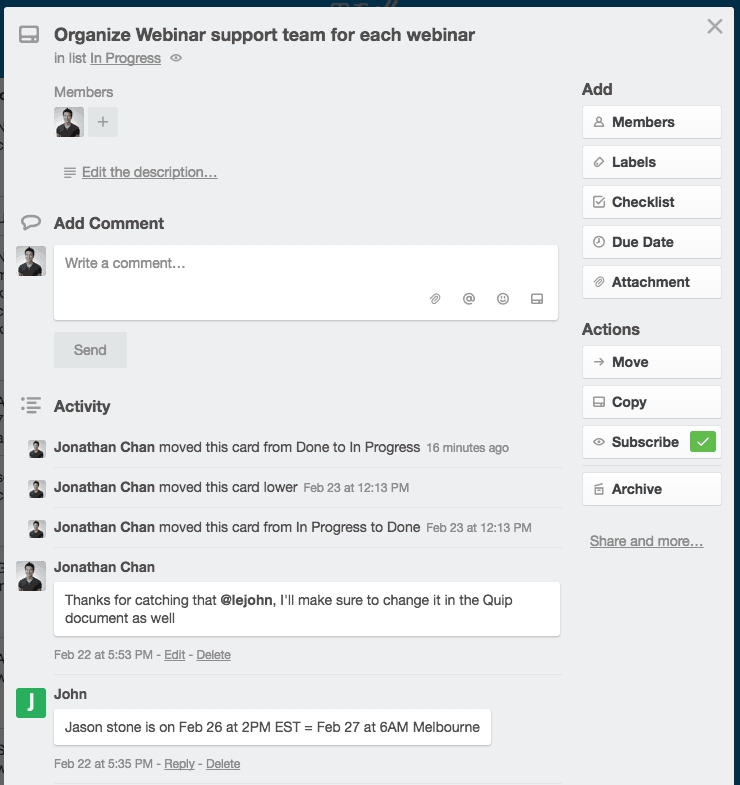
We could even hold discussions on the Trello card itself, or in today’s case the Asana Card, and tag the necessary people if something needed to be clarified or additional information was needed. This meant that we never needed to assign more than two people on a single task at any given time.
We could all move independently of one another while still monitoring each other’s progress.
Another important part of the process is the meetings.
For us, that meant we would have an in-depth meeting at the beginning of every week where we’d discuss everything to do with the project. It also meant that no matter what, rain, hail, or shine, we would hold a daily meeting at noon with every core member of the launch. It was mandatory that everyone attended these launches, no matter what.
These daily meetings were often quick, lasting no more than 15 minutes. Each team member would be given a couple of minutes to run through these three questions:
- What did you do yesterday?
- What are you working on today?
- Is anything holding you back?
By answering this simple set of questions, everyone knew what was going on. It served the dual purposes of keeping each person accountable for their own tasks at all times and keeping everyone as focused as possible on delivering results.
Now that we have delved deep into the process behind our first launch, let’s have a look at planning the “story”.
READ MORE: How To Develop An Online Course
The Story
No matter how logical we are, humans are ultimately emotional creatures. A product launch that does nothing but spit facts and shout that a product is the best will not be engaging to your audience. It’ll probably even be super boring.
Using the power of the narrative makes your marketing message more appealing to your audience. We are all natural storytellers with preset narratives running in our heads all the time—it’s just how we organize and process information. By presenting a story, you’re making your message more digestible, engaging, and memorable.
When it comes to creating a story, you need to adopt the Three-Act Structure model. The three-act structure is basically a model that divides a story into distinct parts: the Setup, the Confrontation, and the Solution. It is a very basic template that many professional writers turn to.
It tells the journey of the protagonist who encounters a problem, experiences conflict because of the problem, and then resolves that conflict at the end.
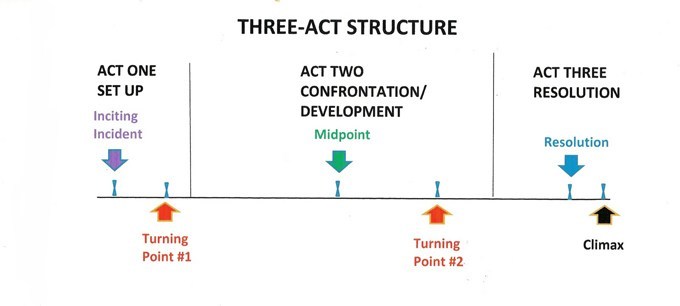
As a marketer, the one thing you need to remember when you’re crafting a story is that you’re not the hero of the story. The real protagonist is your audience. Rather than telling them a story, you’re positioning it so that they are part of your story.
Your job is to guide them through your three-act structure.
The best way to do that is to position yourself as a mentor. Someone who, with their wealth of experience and knowledge, will guide the protagonist through the conflicts they’ll inevitably encounter and help take them to the promised land.
With Instagram Domination, we knew what narrative we wanted to tell.
Storytelling is very powerful, but if you do it wrong, it comes off as inauthentic and pushes the audience away. So using Nathan’s own actual story about Instagram was about as personal and as authentic as we could get.
Our story went like this, and you’ll be able to pick out each of the three acts fairly easily:
- Instagram was an incredibly popular platform and it was definitely the place to be.
- However, learning how to master Instagram was a time-consuming and confusing process.
- But once we learned how to use the platform, we were able to take our business to the next level.
We then highlighted how Nathan himself went through that journey and what he learned from it, all culminating in an epic online course on the best way to use Instagram.
Not only did using Nathan’s journey help hammer home all the points we were trying to make, but it also positioned Nathan as the experienced mentor who could guide you through each stage of the journey.
The goal was to take our potential customers through this narrative using the content we were releasing prior to and during our launch.
READ MORE: Psychographics 101: Everything You Need to Know; How It’s Used in Marketing
The Launch Sequence
Now that you’ve figured out what kind of story it is you want to tell, here comes the nitty-gritty part: putting together your launch sequence.
If your story is the heart of your launch then the launch sequence would be the skeleton. Everything you do from this point out will be building off the launch sequence that you create.
Just like in a regular launch sequence, you’re looking to map out the key events that’ll take someone from potential customer to actual sale. Your launch sequence is essentially your story being given tangible shape. How you guide people through this sequence is up to you.
The best way to create your launch sequence is to just start off with simple timelines and build on it from there.

First, you need to figure out the key dates within your sequence, like when you’re opening the cart and when you’re closing it. While some product launch teams give themselves flexibility in terms of their key dates, we made the active choice to stick to our chosen dates as firmly as possible, to stay focused and motivated, knowing that the finish line was getting closer and closer.
I should also mention that we were very realistic about the dates we chose. Putting unnecessary pressure on yourself makes you sloppy and more likely to cut corners, something you definitely don’t want to happen during a product launch.
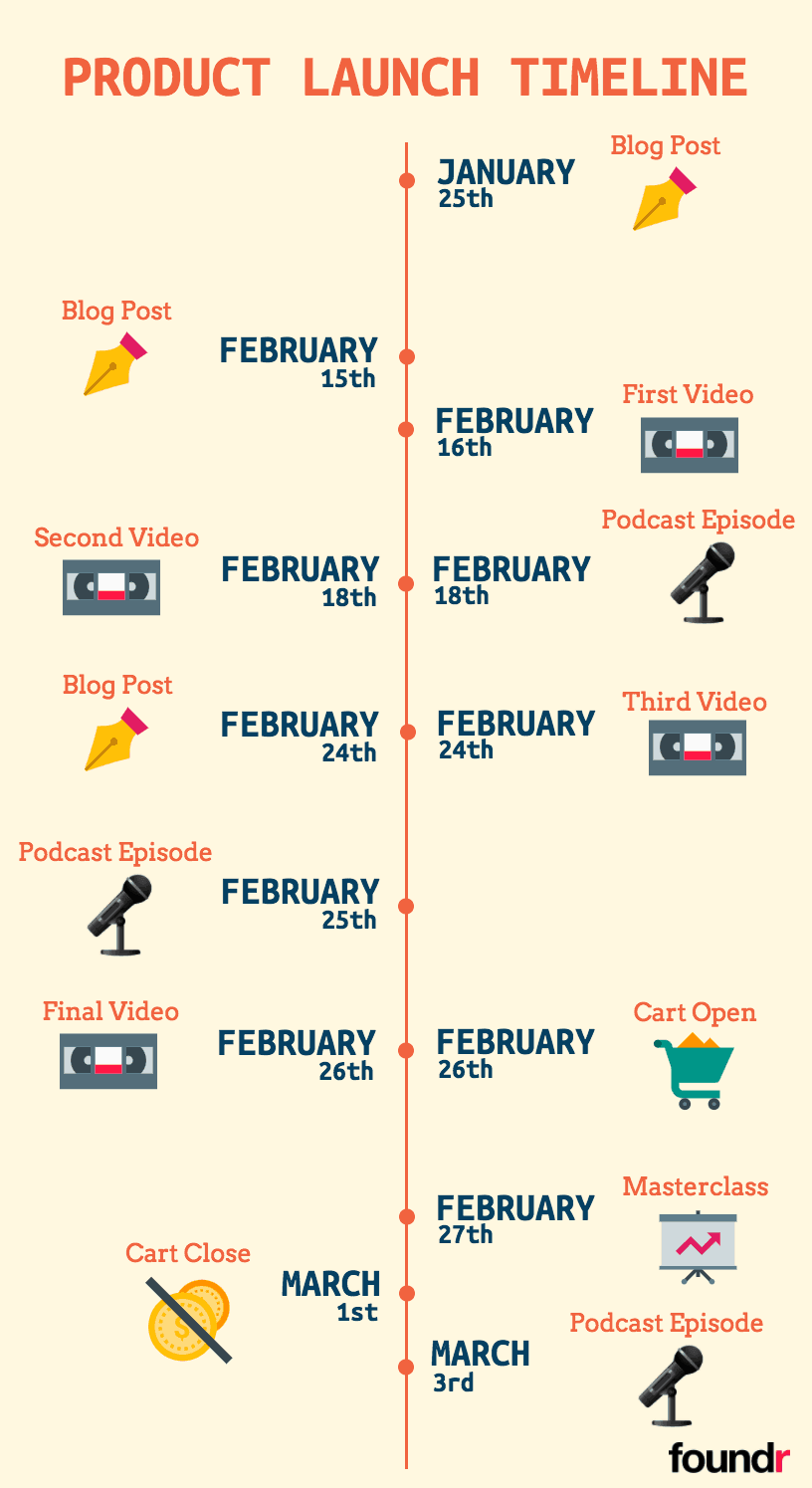
The next step is to extend that timeline so it covers pre-launch as well. After all, you can’t just throw the doors open. A great launch builds the right amount of excitement, so when you do open up it’s like Black Friday.
Now start filling it out with the content you’re going to send out before and during your launch. Key pieces of content like the videos in your sideways sales letter, the emails you’ll send out, lead magnets you’ll be using, and other marketing content like blog articles and Facebook ads. Once again, be as specific as possible and set hard times and dates that you’ll stick to.
Once that’s done, congratulations! Now you have a visual timeline you can always refer back to when it comes to your product launch.
Finally, using your timeline as a guide, you need to map out your customer’s journey. By this I mean taking a look at your timeline and the pieces of content you’re sending out, and figuring out what landing page each one will lead to.
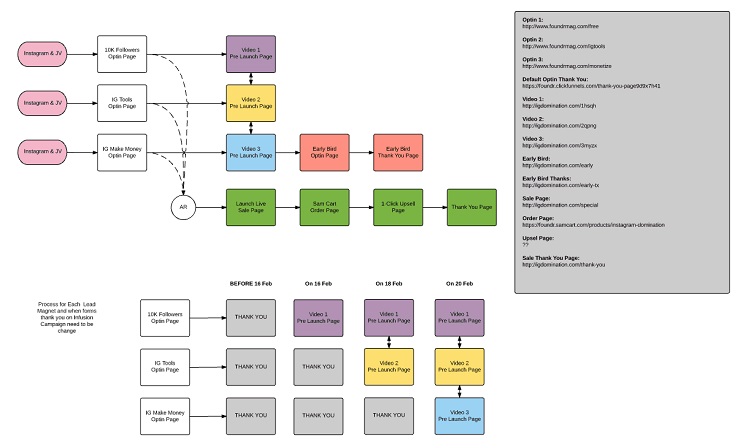
Don’t just assume that people will jump right on board from the start. There will be people who will jump in halfway, or only be aware of your launch when it’s about to wrap up.
That means each piece of content, whether it’s an email or lead magnet, needs to be able to lead your audience member to the relevant landing page, regardless of where they jump in. Otherwise, they’ll have to go all the way back to the start of your sequence and suffer through volumes of content to get up to speed.
All that’s left to do now is combine it with your timeline and you’ve created a guide for you and your team to refer to at any time.
Generating Hype
For most people, this is the trickiest part of a product launch. You can spend months developing a fantastic product and planning an amazing launch, but it won’t matter much if no one hears about it.
On one hand, if you don’t put enough effort into marketing then all your hard work gets swept under the rug and forgotten about. On the other hand, if you hype it up too much then all you’re doing is setting yourself up for failure when your product doesn’t meet expectations.
What you want is to generate just enough hype to get people to start paying attention, and get them to believe in your product so they’ll buy it almost immediately.
When it comes to generating hype for a product launch, I always turn to Apple for inspiration.
Apple is the king of hype as far as I’m concerned.
What Apple does very well is to turn their product launch into a full-fledged event. Launch day turns into a spectacle and everyone pays attention. What you’ll notice in the lead up of any Apple product launch is that they’ll always drill down on the human problems.
Apple doesn’t waste time telling people about the technical specs of their latest product, instead, they showcase all the limitations their product can solve.
They followed this approach even with the very first iPhone launch. Using only one word they’re able to communicate the idea of progress, digital evolution, and the future of technology.
For the launch of Instagram Domination, we incorporated a number of these ideas from Apple and reworked them to fit our brand.
The first thing we had to do was figure out the pain points our target customers were experiencing with Instagram and the biggest benefits our course offered.
We didn’t want to craft a marketing message around every single pain point that people were experiencing, otherwise, the message would come off as cluttered. The key was to take those handfuls of pain points and benefits and keep referencing back to them as much as possible.
After an intense brainstorming session filled with Post-It notes and the Brownlow point scoring system, we ended up with our target list.
For example, we wanted to hammer home the idea of how difficult it was to generate new leads for a business, and how most entrepreneurs don’t have time to devote to social media marketing. We weaved that into a part of our story and highlighted how easy it was to learn how to use Instagram and how our course would teach you everything you’d need to know.
To further drive home the idea of how beneficial Instagram could be to any one’s business, we significantly ramped up the level of content we produced that was centered around Instagram. We used every media channel we had to drive up interest in Instagram as much as we could among our audience, essentially making the case for buying the course before the launch.
We published content about Instagram on our own blog and guest posts, everything from a piece about how we generated half a million real Instagram followers in one year, to submitting articles to Huffington Post about how to create killer Instagram posts. We even published an article featuring the winners of an Instagram challenge we ran among our students to coincide with the launch date.
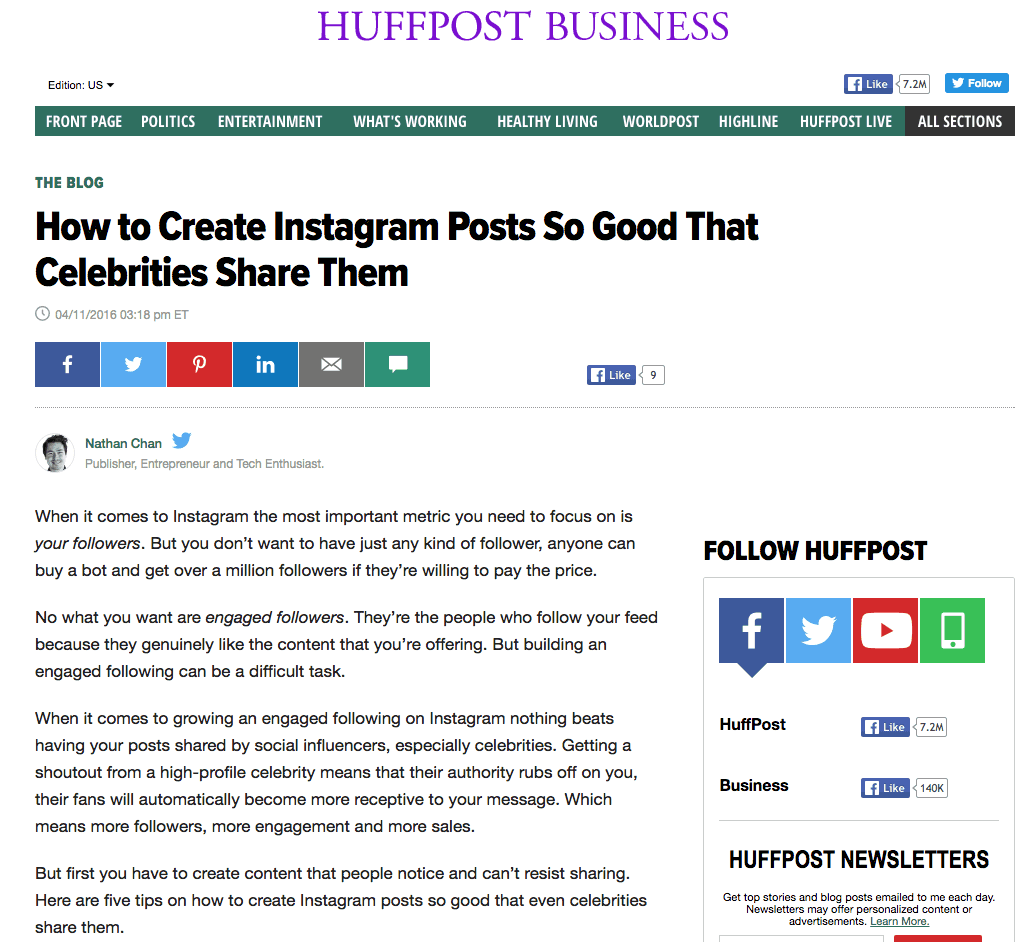
Meanwhile, on our podcast, we featured three Instagram-focused episodes, including interviews with two of our most prominent Instagram Domination students—Deonna Monique, who went on to make a million dollars in sales selling beauty products, and Ramy Georgy, a local dentist who turned his business into a household name.
Not only were they great interviews filled with tons of actionable advice, but they also served as amazing pieces of social proof that could back up the effectiveness of our course.
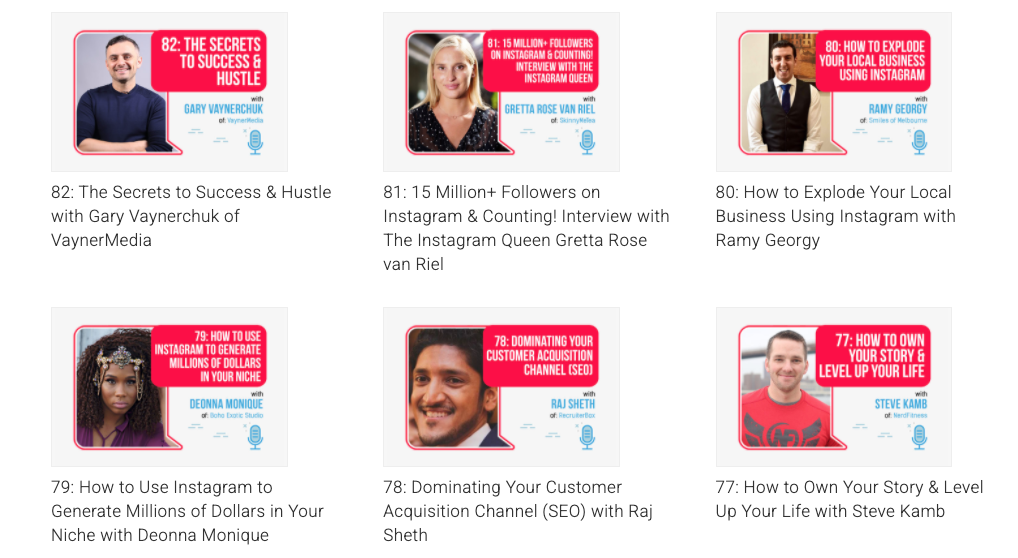 It’s important to note that all of the content we released was never purely promotional. We always created content that was educational and could empower our audience, whether they ended up purchasing our course or not.
It’s important to note that all of the content we released was never purely promotional. We always created content that was educational and could empower our audience, whether they ended up purchasing our course or not.
We were determined to continuously create content that, while focused on a singular topic, would still be valuable enough that our audience just couldn’t wait to see what we had to offer next.
READ MORE: How to Build a Profitable Marketing Strategy
Product Launch Emails
If I’ve said it once, I’ve said it a dozen times, your email list is one of your most important resources as a business, especially if you’re about to do a product launch.
It’s your way to directly communicate with your audience. While it’s great to use other channels like Instagram, Facebook, or even just doing traditional advertising, nothing beats the return on investment that emails can generate.
When you’re doing a product launch, you need to lean heavily on your email list. Not only is it a great way to connect one-on-one, but people on your list are generally not cold leads. You don’t have to worry as much about burning a potential customer because you’re not pitching to them out of thin air.
When you’re guiding people through your story, the people you want to be selling to the most are those on your email list. They’re the ones who already know your brand, have proven to be receptive to your message and will be far more interested in buying what you’re selling.
With that in mind, we started a campaign to grow our mailing list as much as possible ahead of time in order to generate as many warm leads as possible for the launch itself. In one month, we managed to grow our email list by more than 56,000 new subscribers before kicking off the launch of Instagram Domination 2.0.
This was done through a combination of Instagram-specific lead magnets, like hosting public masterclasses on Instagram, or the creation of three eBooks focusing on different aspects of Instagram marketing.

As important as your list is, you can’t just send out email after email letting people know you’re about to launch a product. That won’t get you anywhere and it’s the fastest way to burn your list and lose the trust and loyalty your audience has placed in you.
After all, these are the people who have signed up to your email list trusting that you’ll only be sending them great content. If you neglect that or abuse it, you’re destroying one of your most valuable resources.
That’s why we made sure to create a structure in our emails that would consistently be giving our subscribers value, as well as hyping them up for the launch itself.
In the end, the sequence we used consisted of 16 emails spread out over 14 days—10 going out in the 7 days before the launch date, and 6 going out during the launch period. We set up that email sequence to sync with our launch sequence we developed upfront.
We also paid extremely close attention to what was in each email’s copy (the text designed to engage consumers). That meant everything from making sure our language was assertive enough to constantly rework the headlines until we landed on something that was irresistible.
This was actually one of our tougher tasks for the launch because, believe it or not, writing good copy is incredibly hard. We actually went through several rewrites with different people weighing in. From there, it’s just loading them up into our mailing software and scheduling them to go out at the appropriate times.
Another added benefit of email is the fact that we’re able to track the open rate of our emails and the number of people who clicked through the links. This gives us invaluable data when it comes to figuring out whether or not our email copy is working or if there’s something in the process we could refine.
Sideways Sales Letter
A key element of the Jeff Walker style of product launches is leveraging the power of the sideways sales letter.
You’ve probably seen the long-form sales letter before, also known as long copy, which has been used to sell products for years. It’s that humongous wall of text that you’ll often encounter when you’re looking to buy something online.
The basic anatomy of a long-form sales letter is that you’ll have a very strong headline or “deck” that’s big and flashy and designed to get someone’s attention. Then you’ll move into the introduction or “lead,” which is designed to touch upon an emotion get you to keep reading. From there, you move into the “body copy” that will sometimes tell you a story, and you’ll often find pieces of social proof scattered about, all basically preparing you for the sale.
When you reach the end, you’ll be hit with the offer, the price, the guarantee, and any other bonuses. Usually, it will end with a summary reminder of the scarcity, benefits, and value of the offer in order to entice you to buy more.
Some things will stand out to you, but for the most part, you’re likely to just read the first two paragraphs, scroll down to the bottom of the page to balk at the price, and then close the window.
That isn’t to say that long-form sales letters can’t work. In certain contexts, they’re great for conversions, but the fact of the matter is that they’re just not great for product launches. Most people these days want information upfront and right away, and reading through pages of text isn’t exactly appealing.
In order to combat this, Jeff Walker decided to innovate the sales letter by literally turning it sideways.
Instead of asking your audience to scroll through pages of text, you release that content steadily as part of your pre-launch period, over the span of anywhere from a few days to a week. Although, depending on your launch, this can easily stretch out to several months if you were so inclined.
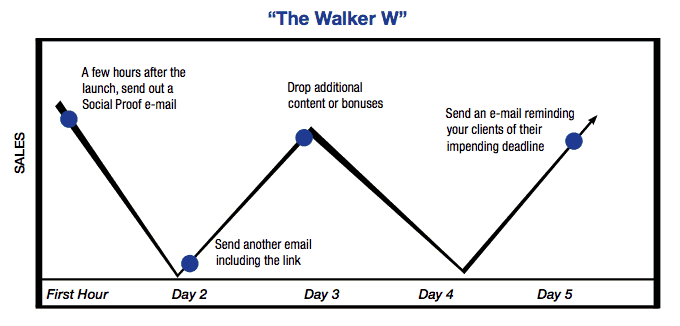
In order to make this sales sequence more engaging, Walker highly recommends using video, as opposed to text. Video is just infinitely more engaging than text. People are naturally drawn to visuals, and video offers the ability to connect on an emotional level with your audience by giving them a face to associate with.
It’s no secret in marketing that people are more likely to respond positively if it’s being delivered by another person. It just makes the message feel more authentic and creates a stronger emotional connection.
We followed the Jeff Walker formula closely when we were creating our own sideways sales letter and videos for the product launch, keeping with the principle of making sure we offer a ton of valuable content.
One unexpected outcome of the videos was that they proved to be a smash hit, far exceeding our expectations. They were shared thousands of times and we had nearly 100,000 views in two weeks, plus over 1,200 comments on all three videos.

Our Sideways Sales Letter
For our sideways sales letter, we constructed three videos for our pre-launch period with a fourth and final video being released on the launch date.
Like with our email sequence, each video had to serve a distinct purpose while still being a piece in the overall puzzle. With help from Melbourne SEO, every video was designed to generate maximum interest in the launch by giving away as much actionable information as possible.
Here’s a full breakdown of each video so you can create your own sideways sales letter.
Product Launch Video #1
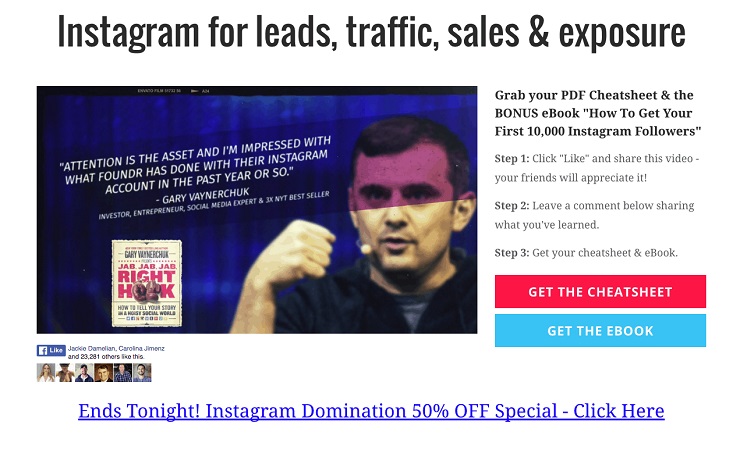
The purpose of the first video was to start generating interest in the Instagram Domination course and introduce our story.
The video begins with Nathan telling the story behind Instagram Domination, then it moves onto our first piece of actionable advice where we show everyone the power of Instagram.
We then included case studies as social proof before ending the video with a sneak peek into the course to generate more interest.
Product Launch Video #2

The second video’s purpose was to seed the idea of the course even further by, once again, demonstrating the power of Instagram. This time our actionable tip was on how to easily create content for Instagram that’ll get you results, along with a downloadable ebook so people could immediately start taking action.
It is incredibly important that you give away as much value as you can with your videos, to the point that even if the person watching doesn’t end up buying, they’ll still leave with a positive impression of Foundr.
The video goes on to give more social proof through some case studies, and we introduce scarcity into the message, highlighting the fact that what we’re offering will last for a limited time only.
Product Launch Video #3

The final video in your pre-launch sequence should be used for objection handling. After the first two videos, your audience will have some questions that they’ll need to be answered before they purchase.
Our third video began with a FAQ format where we answered the top questions we received about the Instagram Domination course. We made sure to not only answer questions but give away as much actionable advice as possible in our answers.
The video then ends with even more case studies of all the success our students have achieved from going through our course. We make sure to include social proof wherever possible.
Product Launch Video #4

The fourth and final video is the VSL, otherwise known as the Video Sales Letter. This is essentially what the sideways sales letters were generating hype for and essentially what the whole launch has been leading up to.
The purpose of the VSL, if you haven’t guessed from the name already, is to sell.
After letting people know about our story, and providing them with tons of value, now is the time to cash in on all that goodwill and give people an offer they couldn’t refuse.
You’ll notice that our VSL has a whole page of its own, and we made it so that it auto-played and the viewer would be unable to pause or skip through it at all. This was to make sure that people got the full value of our pitch, which included a number of bonuses throughout the video.
Something else I want to point out is how prominent our call-to-action is, with our “Enroll Now” button, along with our timer at the top of the page. By making our CTA as eye-catching as possible and by introducing scarcity we’re able to drastically increase our conversions and encourage people to purchase.
Affiliates
Another key feature of the Jeff Walker style of product launch is using the power of affiliates.
No matter how well you set up your launch sequence, or how great your email copy may be, it’s tough to hit your goals without some affiliates. It’s not impossible to have a great launch without affiliates, but they greatly increase your chance of success.
A common stumbling block that product launches face is that they lack the proper channels for distribution. They’ll do everything else right, but struggle with actually getting people outside of their pre-existing customer base interested in what’s happening.
It’s like the one about the tree falling in the woods. The same thing goes with producing epic content for a product launch—it won’t matter all that much if people aren’t aware of it.
The best, and easiest, way to sidestep this problem is to start working with affiliates, also known as JVs or Partners. By doing so, you’re not promoting your product to just your audience, but to theirs as well.
Let’s say you have an email list of 100,000 subscribers, so when you do a product launch you’re effectively advertising to about that many people. You might even pick up another 10,000 here and there, depending on how good your promotion strategy is. Which is great, nothing wrong with that.
But what if I said that you could get your launch in front a guaranteed million, if not two or three million, people instead? And not just cold leads, but people you know will be interested in what you’re selling?
That’s exactly what you’ll be doing when you work with affiliates.
Working with an affiliate simply means having them promote your product launch to their audience. You’re leveraging their ability as an influencer to help you generate more leads and sales.
The first step to finding such partners is to make sure that you have a great product to begin with. Affiliates will not risk burning their audience by promoting something substandard. You need to make sure that their audience will definitely love what you’re selling.
You also have to make sure that you’re offering a mutual exchange of value in return, whether it’s leveraging a pre-existing relationship, paying them outright, or negotiating a deal of some sort. We relied a lot on our brand power and the goodwill we’ve built up over the years as leverage, and offered deals where we would help others with their future launches or host masterclasses or webinars for their audiences.
For our product launch, we put together a list of 10 core affiliates to work with, making sure that they possessed an audience similar to ours and that they were familiar with our brand.
READ MORE:How to Create an Online Course Like Foundr
We first began reaching out to people we had worked with before, whether it was people we’ve interviewed for our podcast or entrepreneurs we’ve featured in our magazine. Then we started contacting people who were in a similar niche to ours and we knew we wanted to work with. Luckily enough, our brand had grown to the point where we even had people volunteer to partner up with us for our launch.
From there it was just a matter of coordinating everyone on our list and figuring out how each person would be helping us through the launch. First and foremost, we wanted to have them promote the launch through their email lists.
This can be tricky to negotiate since, like us, influencers will guard their email lists as much as possible. But if they’re game, all you have to do is send them a proposed draft of the email copy you want sent out, which they’re free to edit, and a basic timeline of your launch.
You want to make this process as easy as possible for your partners.
After all is said and done, make sure you stay on top of your affiliates. This means getting in contact with them every day in the lead-up to the launch to make sure you’re all on the same page.
And remember, you’re not ordering them to do something for you. You have to approach it with the mindset that you’re working together.
Facebook Advertising
Facebook is the big gun of the social media world and while not absolutely crucial in running a successful product launch online, the benefits it brings are huge. We believe a very important part of a companies marketing strategy is to have all forms of media (owned, earned and paid). Facebook is a brilliant source for paid acquisition right now.
In fact, our Facebook campaign was one of our best lead generation sources. A significant percentage of our conversions were actually generated through our efforts on Facebook. We were able to generate a conversion rate as high as 60% and we even managed to keep costs well under $2 per lead.

With help from the Facebook marketing experts at PPC Empire we set about building our Facebook campaign. Creating a Facebook campaign is like creating any other sales funnel, you need an objective, you need your lead magnets, and you need to get those lead magnets in front of your audience.
In fact, we based our Facebook campaign on our pre-existing sales funnel, simply adapting the lead magnets we already had to create our Facebook ads. After that it was just a matter of leveraging the power that Facebook offered.
There are essentially three reasons you should use Facebook for a product launch.
The first is Facebook’s ability to bring in cold leads, people who have never been in contact with the brand before, and actually convert them. As long as you have a proven and working sales funnel, something we had perfected with when building our email list, running a Facebook campaign is like adding gasoline to fire.
One of the reasons Facebook is so powerful is that you’re able to do targeted advertising. We targeted our demographic of entrepreneurs and people who were looking to seriously utilize Instagram based upon the information that Facebook had gathered.
By using targeted advertising, we were able to make sure that our message got in front of the right people.
The second reason you should be using Facebook during your product launch is that it gives you the ability to remarket and target warm leads.
Remarketing is a tactic that drastically improves your conversions because it allows you to target people who have already visited your website. It’s a pretty straightforward process; basically, anyone who visits your sales page or website gets tagged with a pixel and placed on a special list. What you’re then able to do is create custom ads that only show up only for people who are on your list.
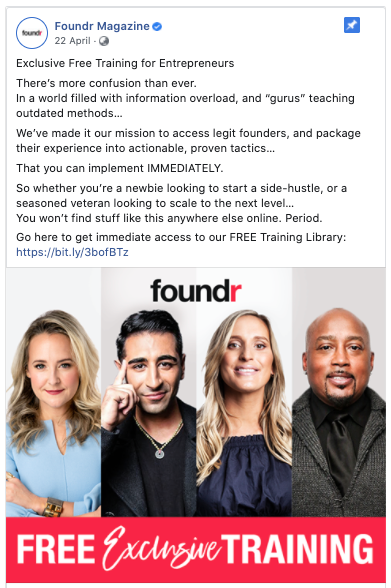
This means that your Facebook ads are reaching people you know are interested in your brand and, more importantly, what you’re selling. You’re able to reinforce the awareness of the brand and remind them that your product exists.
Many marketers lament the fact that you basically only have one chance to convert a lead into a sale. With remarketing you get a second roll of the dice, with a much higher chance of winning this time around.
Lastly, a Facebook campaign allows you to make the most out of your affiliate network.
When you’re working with affiliates, you want to get as much value as you possibly can out of them. Not only can you get them to share your Facebook ads, but you’ll also be able to remarket to the people who visited your sales page through their link!
Onboarding
Most businesses have some semblance of an onboarding sequence regardless of the type of product or service you’re selling. Simply put, onboarding happens every time you purchase a product and you’re given a walkthrough on how to use it.
It can be as simple as having a folder full of the necessary information, like when you check into a hotel, or an offer for a free tour or consultation when you sign up for a SaaS. Another example of onboarding would be when you play a video game for the first time and you’re given the option to go through a “tutorial mode.”
Onboarding is a crazy important part of the sales process. Too many entrepreneurs make the mistake of thinking that the process ends once you’ve sold the product. In reality, just because someone buys your product doesn’t necessarily mean they’ll stay.
Bad onboarding practices can lead to a poor customer retention rate and a steep increase in customer churn. If customers become too frustrated and leave with a bad impression, it can even damage your reputation.
It’s kind of like when you get really, really excited for something, and when you finally get it you realize it’s confusing, not what it was cracked up to be, and ultimately severely disappointing.
There are essentially two different types of onboarding you can do.
Low-touch onboarding is usually for when you have a pretty self-explanatory product and all you really need is a passive support system. Think of those simple “getting started” manuals you get when you buy a new phone or those welcome emails for when you sign up for a new tool or service. It’s those light touches and details that make a new customer feel welcomed and assured that they’re being taken care of.
However, as soon as your product gets even a little more complex, you need to start implementing high-touch, or concierge, onboarding practices. This is when you actively reach out to your customer and answer their questions, actively helping them where need be. For products that aren’t intuitive and have a steep learning curve, you absolutely need a concierge-style onboarding process.
Knowing that we would be taking on an influx of new customers, we at Foundr began tightening up our own onboarding process.
This involved bringing an additional team member on board to handle customer support questions because we knew that our current lineup just wasn’t equipped enough to handle the numbers we were expecting.
Using Helpscout, we were able to coordinate with one another and assign the questions we received to the appropriate person.
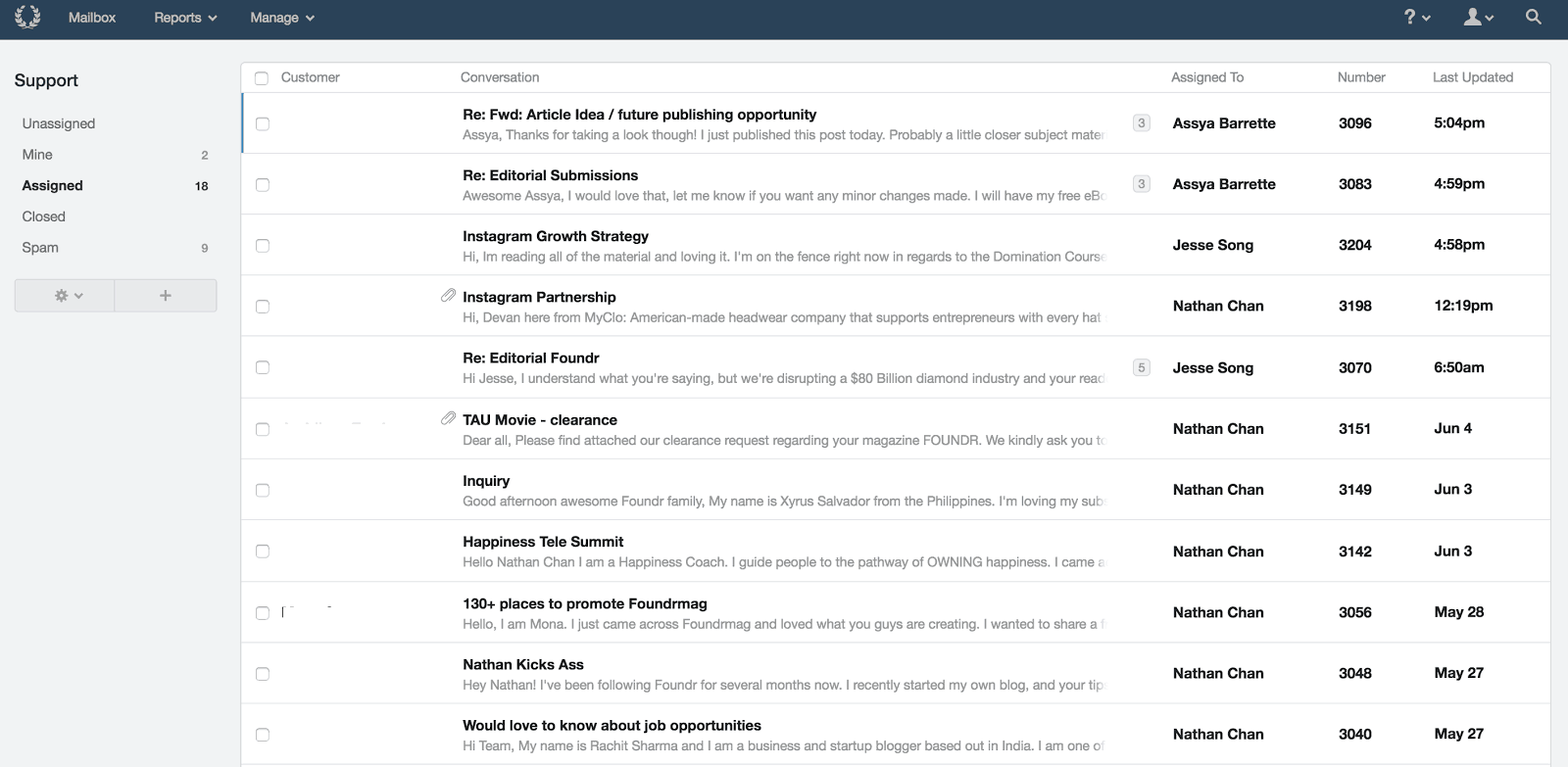
You can even create a series of onboarding videos that appear for every new customer—just a simple virtual tour to tell people what to expect.
Ready To Launch Your Product?
We had tremendous success with this approach ourselves, and I think there are some universal lessons to take home from our experience. For one, the preparation is half the battle—actually, more like 90% of the battle. The product launch itself was a relative blip in relation to the tremendous work we put into the ramp-up.
There’s also something to be said here about the power of collaboration. We knew we couldn’t do this alone, and we called upon the strength of our community, both recruiting new people to our team and partnering up with our respected peers and allies to get the job done. And, of course, you just gotta have a great product.
What about you, Foundr family? Have you had any noteworthy experiences with a product launch? Any tips to improve our process, or questions for us? Join in the comments below!
The post How Foundr Pulled Off Our First Successful Product Launch appeared first on Foundr.
via https://AiUpNow.com November 15, 2020 at 11:31PM by Jonathan Chan, Khareem Sudlow,


